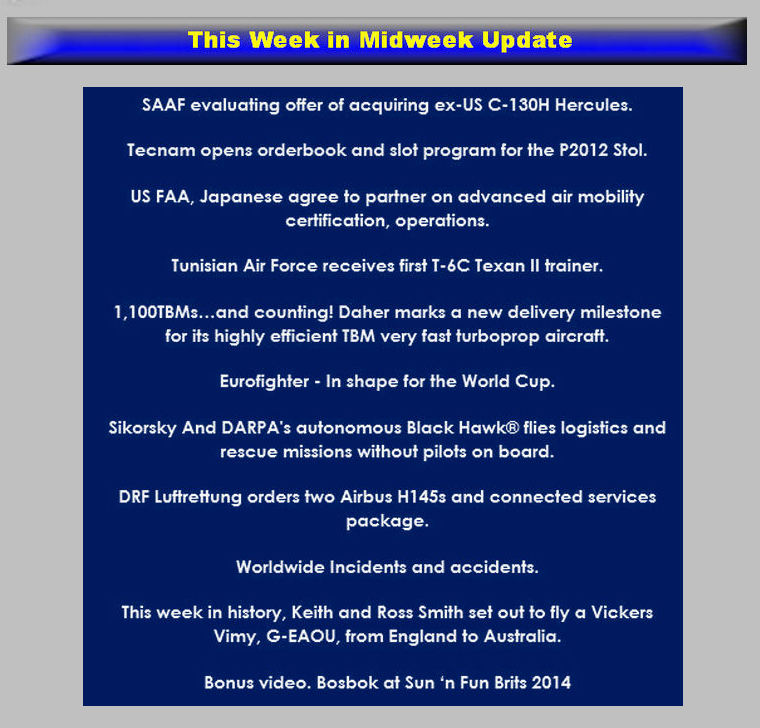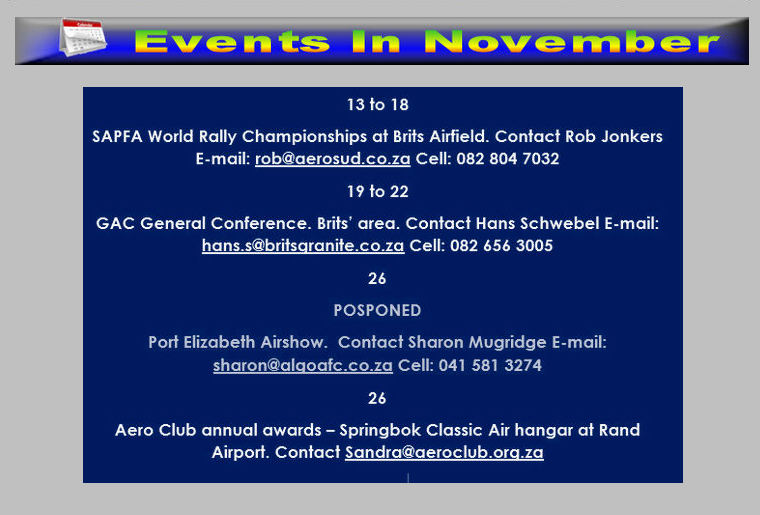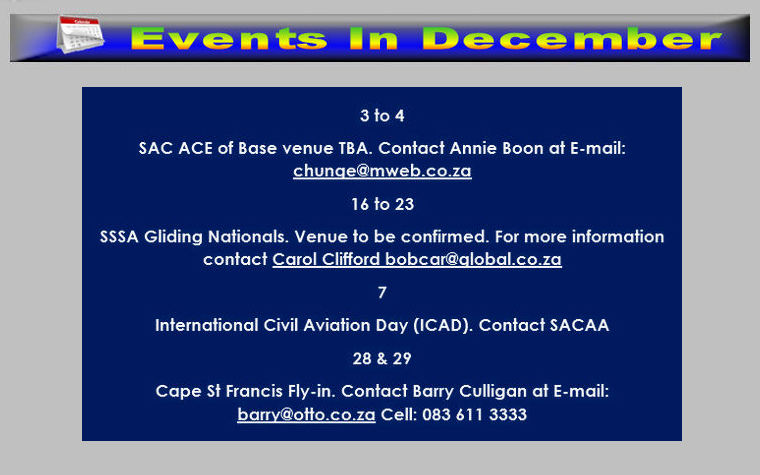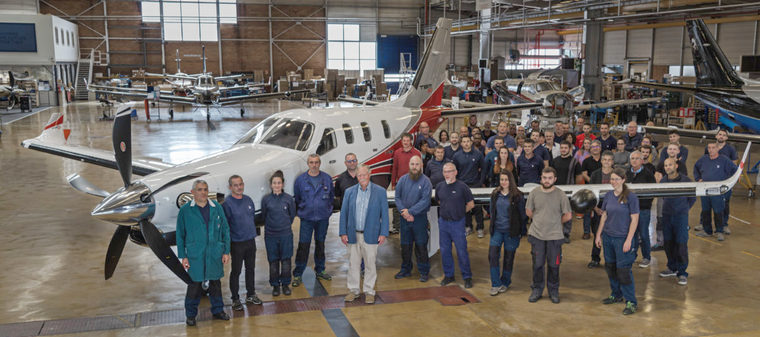








MIDWEEK UPDATE 16 NOVEMBER 2022Google Banner Ad       .jpg)   Guy Martin defenceWeb The United States has offered South Africa retired C-130H Hercules transport aircraft to replace its ageing C-130BZ fleet, with the South African Air Force (SAAF) presently considering the offer. Africa Intelligence reported that the United States is offering a dozen 1980s-era C-130H transports under the Excess Defence Articles (EDA) programme. “A team of South African Air Force technicians travelled to the United States last month (September) to scout available equipment and exchange views with their US Air Force (USAF) counterparts,” the publication reported. African Defence Review Director Darren Olivier cautioned that the extremely low South African National Defence Force (SANDF) budget is the main limitation in pursuing this. He added that there are a number of factors that go into deciding whether to take up the US offer, including the fact that the C-130Hs would need upgrades before entering SAAF service. “What's presently unknown is whether the USAF has offered any grants for the aircraft (nominally +/- $12 million each) and the necessary upgrades. That'll change the calculus dramatically, of course. My understanding is that a full grant is not on offer, but there may be discounts.”  Olivier noted that “no decision has yet been made, as it will depend on the post-inspection report and whether this does turn out to be more cost effective than upgrading the existing C-130BZs.” In May this year, the Department of Defence revealed that it was exploring upgrading the C-130BZ Hercules fleet at a cost of R1.6 billion. Defence Minister Thandi Modise also revealed that the United Kingdom had offered to sell South Africa surplus C-130J Super Hercules, while the US was offering excess C-130Hs. The SAAF considered three options, Modise explained. The first was to spend no money and decline the purchase of second hand aircraft and not upgrade the current C-130BZ fleet - this would mean aircraft lifespan terminates in 2024. The second was also to decline the purchase offer and upgrade aircraft currently in 28 Squadron's inventory, returning to service “the rest of the fleet”. Upgrade cost is estimated at R1.6 billion for five aircraft presently in service aircraft and one in long term storage. This would enable the C-130BZs to remain airworthy until 2040, Modise stated. The third option is to accept the US offer and simultaneously upgrade the current fleet of five aircraft for R1.6 billion. Second-hand C-130H models would be able to serve until 2028 and the C-130BZs until 2040. “The SAAF considered option two,” Modise stated at the time, adding that the door for additional Hercules transports was not completely closed.  Either way, the SAAF will have to spend money to maintain a Hercules capability. It will now have to determine whether spending R1.6 billion on upgrades is cheaper or more expensive than refurbishing excess C-130Hs. It is likely that a decision on the US offer will be reached in a few weeks' time.  TECNAM OPENS ORDERBOOK AND SLOT PROGRAM FOR THE P2012 STOL During the press conference held at NBAA, Tecnam presented to US media the new P2012 dedicated to Short Take Off and Landing (STOL) operations and the program to secure the available production slots. Specifically designed to operate across the most demanding commercial airports in the world, addressing the needs of a market niche that was left undeveloped and unsupported for decades, Tecnam is once again providing a solution to those operators that seek for their business a modern, spacious, comfortable, safe, yet stylish aircraft, with ultimate STOL capabilities. The P2012 STOL is the only twin piston with Short Take-Off Landing capabilities compliant to the latest certification amendments. A rugged and durable high wing, fixed gear, design is matched to a wide and comfortable cabin, designed to meet today's travel needs in terms of space, safety and passengers' amenities. The interior accommodation is enhanced by a central aisle, a dedicated window for each of the 9 single seats, no bench/double seats and the best passengers' comforts such as USB ports, cabin Air Conditioning, in-seat cabin hot and fresh air outlet, dedicated reading light, seat pockets and cup-holders. Travel ease is further enhanced by the spacious, in-cabin, luggage compartment, additional nose luggage compartment and under seats storage space, features that are uncommon in this aircraft class. The interior design, higher class seat pitch and the superb view provided by the “high wing” configuration provide a “best-in-class” experience for the flights to typical “exotic” STOL destinations. The P2012 STOL is capable to operate from short runways at a remarkable Maximum Gross Weight of 3700 kg / 8158 lb. At Maximum Take-off Weight of 3680 kg / 8113 lb, equivalent to a 1284 kg / 2831 lbs useful load, the take-off run takes only 275 m / 902 ft and to clear the obstacle the take-off distance is achieved in just 430 m / 1.410 ft. At the 3630 Kg Maximum Landing Weight the landing distance from the obstacle takes only 360 m / 1.181 ft and the impressive ground run requires just 155 m / 509 ft to stop the aircraft. At lower weights the STOL performances are even more impressive, with a P2012 matching the take-off and landing distances of the most known British STOL aircraft with a much better passenger accommodation, higher cabin size, greater seat pitch and higher luggage allowance. In this comparison, from a comfort perspective, the P2012 STOL offers a +34% wider cabin, +24% larger seat pitch, +188% higher luggage weight allowance and +303% better luggage volume and does it all complying to the latest certification amendment requirements. While accomplishing the STOL mission the P2012 outperforms its competitor useful load by 215 kg /475 lbs, which is a 21% improvement up to a remarkable value of 1284 kg / 2831 lb. Mission accomplishment and flight safety enhancement pass through a modern cockpit, tailored to facilitate single pilot operations, with latest technology, including state-of-the-art G1000 NXi avionic system and GFC700 autopilot specifically tuned for the STOL mission. Active and connected flight deck (Bluetooth, flight stream, Iridium) and a toolbox of modern aids (Weather radar, storm scope, inset map, Synthetic Vision™) are provided to reduce workload and fatigue while increasing mission effectiveness. There are hundreds of regional and local STOL airports around the world needing the P2012 outclassing airframe, its superior performances, the latest safety and a 21st Century comfort and design capable of operating from prepared and unprepared strips of less than 300 m / 1000 ft. P2012 STOL The P2012 STOL, developed by the renowned and innovating Tecnam Research and Development team, is available in different cabin configurations (passengers, combi, cargo, air ambulance, SMP). Fully interchangeable, the 11-seats, twin-engine, fixed gear, unpressurised Tecnam can quickly and easily be converted from a 9-passenger carrier into a special-purpose aircraft…and back again. The aircraft features are: Two flight deck plus nine passenger single seat cabin accommodation. Two six cylinders, turbocharged, piston engines. Certified Single Pilot VFR and IFR for Commercial Operations. PBN certified for GPS approaches. No type rating issue/renewal required (Multi Engine Piston rating only). Easy maintenance (no hydraulics, no pressurisation, no retractable gear, no turbine engines). Approved for prepared, unprepared runways and steep approaches. Following the successful completion of the preliminary P2012 STOL flight test campaign in early 2022, the aircraft has entered its final configuration moving on to the certification phase in 2023. Tecnam officially opened the order book with the P2012 STOL price starting from 2.75 Mln $ plus options and slots available for deliveries starting Q2 2024 following the launch customers deliveries already allocated between Q4 2023 and Q1 2024. “For decades, the STOL aircraft market has been left undeveloped and unsupported, leaving operators with very little options for supporting and expanding their operations. Tecnam's response to meeting the needs of these businesses is a modern aircraft that addresses current needs with an innovative solution. Manufacturing the STOL of the 21st Century grants accessibility to the world's most remote and challenging commercial airports, increasing the regional connectivity while exceeding customers' expectations”. Said Giovanni Pascale, Tecnam's Managing Director. “Tecnam took up the challenge of providing a modern, safe, and efficient solution to one of the most demanding aircraft commercial missions: the STOL mission. Developing and testing this aircraft provided the opportunity to outperform current ageing aircraft, while complying to nowadays more restrictive and limiting safety regulations. The P2012 STOL delivers best in class take-off and landing capabilities while contemporarily offering the latest ergonomic design and passenger comfort, elevating the passengers' experience in the STOL mission to the ultimate aviation standards”. Said Francesco Sferra, P2012 Sales & Business Development Manager and Experimental Test Pilot at Tecnam.  US FAA, JAPANESE AGREE TO PARTNER ON ADVANCED AIR MOBILITY CERTIFICATION, OPERATIONS  The declaration continues the safety agencies' long partnership and formalises ongoing discussions on certifying and validating new AAM aircraft, production, continued airworthiness, operations and personnel licensing. “The FAA and the JCAB have enjoyed a long and strong working relationship and that will extend into this new era of aviation,” said Acting FAA Administrator Billy Nolen. “Close collaboration with our international partners is critical to successfully and safely integrating these new technologies.” The two agencies will exchange ideas, information, skills and techniques and collaborate on AAM projects and challenges of mutual interest. The announcement follows the FAA's partnering with the United Kingdom, Canada, Australia and New Zealand in the National Aviation Authorities Network to harmonise our certification criteria and integration plans.  defenceWeb Tunisia's Air Force has taken delivery of the first T-6C Texan II trainer aircraft from Textron Aviation Defence as part of an order for eight aircraft. Training of the initial cadre of pilots began on 31 October at Textron Aviation Defence facilities in Wichita, Kansas. The Tunisian Air Force will rely upon TRU Simulation + Training Inc, an affiliate of Textron Aviation Inc, for a suite of training devices and related support. The devices - slated for installation at Sfax air base in Tunisia - include a ground-based training system, an operational flight trainer and a computer-based training lab. The Tunisian contract covers eight aircraft as well as in-country field service and logistics support, program management support, interim contractor support for the first year, training for pilots and maintenance professionals, spare engines, spare parts and aircraft support equipment. In July this year Textron was awarded a $90 million contract on top of a previously awarded contract for Tunisia's T-6Cs - in June 2021 Textron received a $12 million contract for long lead items. In October 2019 the US State Department approved the sale of up to 12 T-6 aircraft to Tunisia for an estimated $234 million and in late 2020 the Tunisian defence ministry announced eight T-6C trainers were being acquired, in addition to a possible four AT-6C light attack aircraft. “Tunisia is the thirteenth nation to acquire the T-6 and has now taken delivery of the 1 001st T-6 manufactured by our team in Wichita,” said Fouad Kasri, director of Sales & Strategy for Africa and the Middle East, Textron Aviation Defence. “Becoming a regional leader in military flight training excellence is one of the milestones on the path to achieving our counter-terrorism and border security mission requirements,” said General Mohamed Hajjem, the Tunisian Air Force Chief of Staff. Tunisian Air Force students do their basic training on SF-260s - Tunisia received nine SF-260CTs and 12 SF-260WT Warriors between 1974 and 1978; about 18 SF-260s remain in use. Tunisian student pilots then move on to the jet-powered Aermacchi MB-326, some 10 of which remain in service - they are the survivors of eight MB-326Bs delivered in 1965, and five MB-326LTs and seven single-seat MB-326KT light-attack aircraft delivered in 1977. The T-6Cs will likely fill the gap between the SF-260 and nine surviving Aero L-59Ts (of 12 delivered) that operate in the lead-in fighter training and light-attack roles. Morocco is the only other African nation that flies T-6s, ordering 24 for $185 million in October 2009. These were delivered from 2011. The T-6 is a development of the Swiss Pilatus PC-9 turboprop trainer and was developed to fill the Joint Primary Aircraft Training System role for the US Air Force and the US Navy. The C model is a further refinement of the T-6A Texan II with an integrated glass cockpit, advanced avionics suite and hard-point wings that can accommodate auxiliary fuel tanks. In addition to the hard-point wings, the T-6C's upgraded avionics include a Head-Up Display, Up Front Control Panel, three Multifunction Displays and Hands-On Throttle and Stick (HOTAS) controls. This equipment mirrors the systems and capabilities of front-line strike fighter aircraft, while retaining all the inherent training and flying characteristics of the T-6 trainer. The AT-6C Wolverine light attack aircraft has seven hardpoints, allowing it to carry 1 860 kg of ordnance including HMP-400 .50 calibre machineguns, Mk 81 and Mk 82 unguided bombs, GBU-12, GUB-58, GBU-49 and GBU-59 Paveway II guided bombs, laser-guided rockets, AGM-114 Hellfire missiles and flares. Targeting is through an MX-15D multi-sensor suite with colour and infrared cameras, laser designator, laser illuminator and laser rangefinder. Both the T-6C and AT-6 share an 85% commonality in structure, avionics, and other systems. Textron has an AT-6 Wolverine on static display at the Bahrain International Air Show taking place this week as the company continues to market the T-6 and AT-6 to potential customers around the world.   Daher has delivered its 1,100th TBM, underscoring the success of this highly efficient very fast turboprop aircraft family and highlighting the popularity of the TBM900-series - which has evolved through the company's strategy of continuous operational improvements and commitment to enhanced sustainability. This milestone aircraft is a TBM 960 - the latest top-of-the-line TBM version - which benefits from Daher's application of digital power for enhanced operating economics, along with a superior piloting experience and increased cabin comfort. The 1,100th TBM delivery occurred just two years after Daher's handover of the 1,000th TBM. Today's TBM production versions - the TBM 960 and TBM 910 - evolved from the initial TBM 700 configuration, which was introduced in 1990 as the first civilian pressurized single-engine turboprop aircraft. It was followed in 2006 by the more powerful TBM 850. The TBM 900-series' launch in 2014 accelerated the aircraft family's success, culminating with the TBM 960, which is the ultimate evolution of the brand today. With the TBM's market position and Daher's 2019 acquisition of the Kodiak product line, the company now ranks among the top 10 general aviation airplane manufacturers. It offers a range of complementary aircraft: the TBM 910/TBM 960, which meet the performance and efficiency requirements of private pilots/owners and governments; and the Kodiak 100/Kodiak 900, which are tailored for diverse applications that range from humanitarian airlift and medical evacuation to the utility, governmental and special mission sectors. Nicolas Chabbert, the Senior Vice President of Daher's Aircraft Division, said the TBM airplane family has distinguished itself through constant improvements in environmental efficiency and operational safety - delivering speed at much lower fuel consumption than competing jets, and incorporating enhancements in flight envelope protection and situational awareness. “The 1,100th delivery is an achievement that we owe to our faithful customers for their continued confidence and which is built on the dedication of our Daher teams in engineering, flight test, production and support,” NICOLAS CHABBERT, SENIOR VICE PRESIDENT OF DAHER'S AIRCRAFT DIVISION Delivery of the 1,100th TBM occurred this month, with the aircraft acquired by Bruce McCollum, an active private pilot who previously owned a TBM 850 and a TBM 900. McCollum met up with his new TBM 960 at the Tarbes, France headquarters of Daher's Aircraft Division, which is the site for the TBM's production and final assembly. Tarbes also is one of the locations for Daher's aerostructures business. McCollum then boarded the aircraft for its trans-Atlantic ferry flight to the U.S., where the formal handover occurred at Daher's operation in Pompano Beach, Florida. “I had a great tour of the factory in Tarbes, which was very impressive: you can feel the dedication of the Daher teams who design, build and constantly fine-tune the TBM,” McCollum said. “Additionally, the breadth of aerostructures that Daher makes for such leading aircraft producers as Airbus, Dassault and Gulfstream also is impressive. Having this diversity contributes to Daher's strength as a company and its ability for future development of the TBM.”  A deployment of the joint RAF-Qatari Typhoon squadron - 12 Squadron - has departed RAF Coningsby to support the Qatar Emiri Air Force (QEAF) with air security operations for the FIFA World Cup. For 12 Squadron pilot, Squadron Leader Luke Wilkinson, the deployment is something the group has been working towards for several years. “It's the absolute capstone of what we're doing,” he says. “It's a great honour to be representing the RAF at a global event but also providing assurance and safe skies for the fans, for the participants and for the organisers of the World Cup in support of our colleagues.” “We've got a good pedigree in terms of major sporting events. I was working on the Olympic Games in London in 2012 and so we fully understand the demands of a layered defence at a global event.” Luke believes the Eurofighter Typhoon has the perfect capability set for the role. “Eurofighter brings height, speed and reach. These are the keys of air power as far as we're concerned. We will be there as a constant presence and we'll be able to react to an absolute multitude of threats very, very quickly. There's nothing quite like the power that comes from the Typhoon in terms of thrust. It is an absolute dream to fly. Eurofighter is an ideal platform for air security. We proved that at the Olympics. But it is part of a layered defence - there'll be other units from the UK Armed Forces supporting the Qatari armed forces with their defence and protection of the World Cup.” 12 Squadron was instigated in 2017 and became a joint squadron in 2020 when the Qatari contingent arrived in the UK. Says Luke: “As their Eurofighter jets were being built, their pilots and their technicians were being built too, to provide them with a day-one capability at Dukhan Main Operating Base in Qatar. It was run like a front-line squadron, with British and Qatari pilots learning from each other. 12 Squadron is a unique squadron - the first of its kind for the RAF since the Second World War - and for Air Commodore Richard Yates, Senior Responsible Officer for the Qatar Air Programmes, it has been a hugely successful endeavour. He said: “We have prepared the pilots and ground crew and provided them with experience in Typhoon operations in advance of the delivery of their aircraft. There are many lessons that have come from the programme, namely the role of partnerships and how the UK and Qatar have been able to work together to realise our shared vision that was set five years ago." Of course, having the World Cup as a point on your project plan does focus attention. But it's been brilliant. “I've really enjoyed this programme. It's had the right amount of ambition, tied in with technical challenge. “I think it was a really bold choice by the UK and Qatar to commit to the partnership and it has been highly successful. Qatar has taken delivery of its first four Typhoon aircraft and they are active and have a cadre of trained pilots. Effectively, they have gained three or four-years' experience ahead of receiving their first aircraft. That's a huge step-up for any air force. “We have been able to deliver on all the things we wanted to do; building their capacity and getting them ready to do World Cup duty within a few months of receiving their first aircraft.” Air Cdre Hall adds Eurofighter brings a number of capabilities that make it ideal for the role. He says: “It's got state-of the-art sensors, it's highly reliable, it's high performance and it's well integrated. There are so many advantages of using Typhoon in this type of mission.”  Sikorsky, a Lockheed Martin company (NYSE: LMT) and the Defence Advanced Research Projects Agency (DARPA) have successfully demonstrated to the U.S. Army for the first time how an uninhabited Black Hawk helicopter flying autonomously can safely and reliably perform internal and external cargo resupply missions, and a rescue operation. Performed on 12, 14 and 18 October as part of the U.S. Army's Project Convergence 2022 (PC22) experiment, the flights show how existing and future piloted utility helicopters could one day fly complex missions in reduced crew or autonomous mode. This would give Army commanders and aviators greater flexibility in how and when aircraft and pilots are used, especially in limited visibility or contested environments. Why It Matters Sikorsky is partnered with DARPA to develop autonomy technology that will exponentially improve the flight safety and efficiency of rotary and fixed-wing aircraft. Sikorsky's autonomy system, known as MATRIX™ technology, forms the core of DARPA's ALIAS (Aircrew Labour In-cockpit Automation System) project. "We believe MATRIX technology is ready now for transition to the Army as they look to modernise the enduring helicopter fleet and acquire Future Vertical Lift aircraft," said Igor Cherepinsky, Director of Sikorsky Innovations. "In addition to increasing flight safety and reliability, MATRIX technology enables survivability in high tempo, high threat 21st Century Security environments where Black Hawk helicopters operate today and DEFIANT X® and RAIDER X® helicopters could operate in the future. Uncrewed or reduced crewed helicopters could safely perform critical and lifesaving missions day or night in complex terrain and in contested battlespace." The Yuma Details During PC22 Technology Gateway, the Sikorsky and DARPA team showed how the optionally piloted Black Hawk helicopter with no humans on board can deliver a large quantity of blood products unharmed by flying low and fast above ground level using the terrain to mask its signature; resupply troops with an external load; and re-route mid-flight to evacuate a casualty. To begin the flight demonstrations, pilots flew and landed the Black Hawk aircraft, then activated the MATRIX system to give full control to the flight computer. When the pilots exited, the helicopter autonomously completed the following mission demonstrations: Long-endurance Medical Resupply: The Black Hawk aircraft flew 83 miles while loaded with 400 units of real and simulated blood - totalling 500 pounds. On reaching 40 miles from its initial take-off point, the helicopter descended into a valley as low as 200 feet above ground level at 100 knots. Cargo Delivery and Casualty Evacuation (combined mission): The helicopter lifted off with a 2,600-pound external load attached to a 40-foot sling and flew at 100 knots for 30 minutes toward a designated landing zone. While in flight, the helicopter was redirected, simulating a scenario in which a threat needed to be neutralised near the primary landing site. Sikorsky demonstrated how a ground operator with a secure radio and tablet can take control of the uncrewed helicopter, command it to release its sling load and then land to evacuate a casualty from a nearby location. Once the manikin on a litter was secured inside the cabin, the ground operator launched the aircraft. During the return flight, a BATDOK health monitoring device integrated with the helicopter's communications system relayed the patient's vitals in real-time to a ground-based medical team. What's Next The PC22 demonstrations were the second set of uninhabited Black Hawk flights this year. Sikorsky and DARPA will continue to work toward the transition of this technology for military operations, such as aircrew support and operations, logistics and medical resupply, casualty evacuation and commercial applications such as firefighting, cargo and urban air mobility.  The two H145s are in addition to the current fleet of 15 H145s and three H135s already ordered in 2020. All 20 helicopters will be delivered to the customer by the end of 2024; 11 of them have already been delivered to the customer. They have already begun replacing older BK117 and EC145 helicopters. The tailored HDataPower pack is a set of digital services designed to improve flight availability and operational safety while optimising costs and sustaining the asset's value. “By leveraging the data generated from helicopter systems, Connected Services provide in-depth analysis of flight, maintenance and logistics operations and set the stage for improvement actions and time savings. Flight Analyser, which supports operational safety and wACS, our wireless airborne communication system, are prime examples,” says Christoph Zammert, Executive Vice President of Customer Support & Services at Airbus Helicopters. “We're honoured to help boost DRF Luftrettung operations, allowing them to carry out their important daily missions.” “Our mission is to continuously improve medical care for people in need. To achieve this, DRF Luftrettung operates the most modern helicopters available, now being the largest H145 operator in Europe. With the new Airbus contract we further enhance our ongoing fleet modernisation thus setting the course for the future”, says Achim Vogel, Head of Central Purchasing and Logistics at DRF Luftrettung. DRF Luftrettung is one of the largest and most experienced air rescue organisations in Europe. The organisation and its subsidiaries operate more than 50 Airbus helicopters at 37 bases throughout Germany, Austria, Liechtenstein and Switzerland for emergency rescue and intensive care transports including special mission profiles such as hoist operations and day and night operations. The new version of Airbus' best-selling H145 light twin-engine helicopter was unveiled at Heli-Expo 2019 in Atlanta. This latest upgrade adds a new, innovative five-bladed rotor to the multi-mission H145, increasing the useful load of the helicopter by 150 kg. The simplicity of the new bearing less main rotor design also eases maintenance operations, further improving the benchmark serviceability and reliability of the H145, while improving ride comfort for both passengers and crew. In total, there are more than 1,500 H145 family helicopters in service, logging a total of more than six million flight hours. Powered by two Safran Arriel 2E engines, the H145 is equipped with full authority digital engine control (FADEC) and the Helionix digital avionics suite. It includes a high performance 4-axis autopilot, increasing safety and reducing pilot workload. Its particularly low acoustic footprint makes the H145 the quietest helicopter in its class.  AOPA - CROSS-COUNTRY CRISIS ACCIDENT CASE STUDY  USA, A Boeing B-17G Flying Fortress (N7227C) and a Bell P-63F King Cobra (N6763) crashed following a mid-air collision during a fly-by at the Wings Over Dallas Airshow at Dallas Executive Airport, Texas, USA (RBD). The formation of three bomber aircraft (B-17, B-24, B-25) and three fighter aircraft (2x P-51, P63) had departed RBD and were approaching runway 31 for a fly-by. At that time the P-63F King Cobra crossed the B-17 from behind and impacted the aircraft just aft of the wings, shearing off the rear fuselage and tail section. Both aircraft broke up and crashed on airport terrain. The occupants of both aircraft. five on the B-17 and the pilot of the P-63, died and both aircraft were destroyed.  USA, about 6 mi SE of North Platte Airport-Lee Bird Field NE: A Lakala Aviation Inc Piper PA-46-500TP Malibu Meridian with two on board crashed in a wooded area, some 6 miles south-east of North Platte Regional Airport, Nebraska, USA. Weather at the airport was poor with limited visibility (4-5 miles), overcast clouds at 300 feet and occasional freezing rain. The aircraft was destroyed and, the 2 occupants were fatally injured. Australia, Sydney-Kingsford Smith International Airport New South Wales: QantasLink de Havilland Canada DHC-8-202 Dash 8 with 28 on board upon landing at Sydney- Kingsford Smith International Airport (SYD/YSSY), New South Wales, a fire broke out in the landing gear of a QantasLink de Havilland Canada DHC-8-202 Dash 8. There were no personal injuries to the 24 passengers and crew members. Australia, Kybong, QLD: A Kappa KP-2U Sova Sabre and a glider collided in mid-air near Kybong, Queensland. Both pilots on board the two aircraft died and both aircraft were destroyed.   12 NOVEMBER 1919  In 1919 the Australian government offered a prize of £A10,000 for the first Australians in a British aircraft to fly from Great Britain to Australia. Smith and his brother Keith, Sergeant James Mallett (Jim) Bennett and Sergeant Wally Shiers, flew from Hounslow Heath Aerodrome, England on 12 November 1919 in a Vickers Vimy, eventually landing in Darwin Australia on 10 December, taking less than 28 days, with actual flying time of 135 hours. The four men shared the £10,000 prize money put forward by the Australian government.   Bosbok at Sun 'n Fun Brits 2014 Google Banner Ad  |
                            |
 |
 |

Copyright © Pilot's Post PTY Ltd
The information, views and opinions by the authors contributing to Pilot's Post are not necessarily those of the editor or other writers at Pilot's Post.